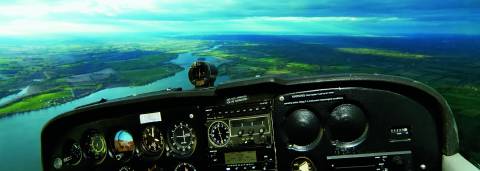How many times, while flying in the thick of things, did we wish aviators had something better than “needle, ball and airspeed” at our disposal in case the attitude indicators fail?
Granted, needle, ball and airspeed — that is, turn coordinator and airspeed indicator — get the job done and have saved many lives along the way. Still, the mental workload required when flying this set of instruments is considerable, and this skill needs to be carefully honed.
How many times, while flying in the thick of things, did we wish aviators had something better than “needle, ball and airspeed” at our disposal in case the attitude indicators fail?
Granted, needle, ball and airspeed — that is, turn coordinator and airspeed indicator — get the job done and have saved many lives along the way. Still, the mental workload required when flying this set of instruments is considerable, and this skill needs to be carefully honed.
Unfortunately, many cockpits of general aviation (GA) aircraft are still equipped with only a single attitude indicator, and pilots have to rely on needle, ball, and airspeed as their backup option in case their primary instrument fails. Although an increasing number of glass cockpit–equipped GA aircraft are emerging in today’s market that do provide redundancy, the majority of the GA fleet does not benefit from this leap in technology because of the high cost of these systems.
On the upshot, technology advances have enabled some aircraft operators to get an affordable back-up option over the years, such as handheld radios or GPS moving maps. The latter typically indicate ground track as well, which may serve as a substitute for heading, if need be. But wouldn’t it be nice to have a handheld backup attitude indicator as well?
The following article describes a low-cost, handheld, single-antenna, GPS-based aircraft attitude indicator that we recently flight-tested. While a number of companies have commercial products on the market that emulate cockpit instrumentation displays, these devices typically cost several hundreds (or thousands) of dollars, display merely turn rate (not attitude), are limited by a low update rate, and thus are not suitable to provide meaningful aircraft attitude information.
The attitude indicator described in this article, on the other hand, displays attitude information at a high update rate and relies on a $150 GPS receiver and a portable digital assistant (PDA).
Single-Antenna GPS-Based Attitude
Research performed a few years ago by the author, John Hansman, and John Deyst at the Massachusetts Institute of Technology (MIT) addressed this question and resulted in an approach to obtain attitude information from a single-antenna GPS receiver.
We derived this approach from a basic notion taught in every ground school: When the aircraft is flown in a coordinated turn (“ball in the middle”), then the turn rate and the roll angle are closely related to each other. The turn rate itself can be derived from the velocity information that the GPS receiver provides. That is, by using the measured lateral rate of change of the velocity vector, a roll substitute can be computed.
We demonstrated that under coordinated flight conditions, the computed roll angle corresponded very closely to the roll angle shown on traditional attitude indicators. The assumption of coordinated flight is valid for most flight conditions encountered by conventional aircraft and, thus, does not constitute a significant limitation to this concept. We can show that the synthesized attitude information is also useful in the presence of moderate sideslip conditions.
The second attitude component used in this approach is flight path angle. This can also be derived from velocity information measured by the GPS receiver and used in place of the traditional pitch indication. In fact, flight path angle is offset from the latter by the angle of attack and is a direct indication of the aircraft flight path.
We generally refer to the set of computed roll angle and flight path angle as pseudo-attitude to distinguish it from the traditional attitude as provided by a vacuum pump–driven attitude indicator in a GA aircraft.
. . .
The Emergence of Handheld Computing
With the emergence of massive computing power in handheld PDAs and more powerful and smaller GPS chipsets in the last few years, it was time to revisit this approach and implement a truly handheld back-up attitude indicator. To that end, I chose a PDA as the computing and display platform.
. . .
The Flight Test
To test the system, we chose a clear night last November over the Los Angeles, California, basin. We flew a Cessna C-182RG Skylane aircraft with a 235-HP engine, belonging to Bob Clark, a Los Angeles–based flight instructor who served as test pilot while I operated the system. For this test, we mounted the PDA over the heading indicator using Velcro. This arrangement allowed for a nice side-to-side comparison of both the traditional attitude and the pseudo-attitude indicator.
. . .
Operational Considerations & Conclusions
Although the utility of pseudo-attitude to control the aircraft was demonstrated a few years ago when the MIT team first introduced this approach, the Los Angeles flight test illustrated the possibility of using a PDA and a $150 GPS receiver board to achieve the same goal. Moreover, the hardware was compact, light-weight, and truly portable.
This setup enables a slew of opportunities for handheld devices. For example, handheld GPS moving map devices can also serve as backup attitude indicators displaying pseudo-attitude. Moreover, a handheld, integrated navcom transceiver/GPS receiver could now serve as an all-in-one backup cockpit providing communications, navigation, and now aircraft control as well!
So, what’s the catch ?
A number of factors need to be considered to fully exploit pseudo-attitude based systems. First, because the attitude information is based on the assumption of coordinated flight, it will not show proper indications if the aircraft flies unusual maneuvers or is in extraordinary attitudes, such as during a severe slip, stall, or spin.
Moreover, during severe atmospheric non-uniformities, such as severe gusts, and wind shear, the inertial velocity vector axis and the velocity vector relative to the air may no longer be closely aligned, and in these instances pseudo-roll angle may differ considerably from the aircraft bank angle. (Similarly, it will not show the correct attitude while the aircraft stands still.)
When flying coordinated, on the other hand, or even in the presence of moderate sideslip and atmospheric turbulence, proper attitude information is provided even for very steep turn and climb maneuvers.
As outlined before, we recommend a minimum of 6 Hz GPS velocity update rate for good aircraft control and a smooth display. Most of today’s handheld GPS receiver market, however, still revolves around chipsets providing 1 Hz position and velocity data intended for navigational awareness only. To display pseudo-attitude effectively, GPS chipsets providing 6 Hz or higher are necessary. The good news is that with today’s low power integrated circuits, battery life is not an issue even for faster chipsets.
An additional important consideration is the antenna placement. Careful selection of the antenna location is paramount to good satellite visibility and a smooth attitude display. While an antenna mounted on the outside of the aircraft is the best option, it may defeat some of the appeal of a handheld device. However, a carefully selected spot inside the cockpit, as demonstrated in this flight test, may yield equally good satellite coverage.
Finally, as with all systems relying on GPS, availability and integrity issues have to be addressed. These become even more important if GPS is to be used to provide attitude information in addition to its primary use for navigation, because an erroneous attitude display or the total loss of attitude information may cause the pilot to quickly loose control.
To this end, an effective build-in integrity monitoring system is imperative. Such a system detects if the attitude information is unreliable and informs the pilot of its unavailability. For this flight test, the system monitored the GPS receiver status, the estimated GPS position accuracy, and the DOP values to ensure that proper GPS information was available.
The system described in this article is thus best suited as a supplement to the existing cockpit instrumentation. Should the primary attitude indicator fail, the GPS based pseudo-attitude system would serve as a backup and reduce pilot workload significantly compared to the traditional needle, ball, and airspeed approach. Still, the latter should ultimately be relied upon in cases of insufficient GPS coverage.
For the complete story, including figures, graphs, and images, please download the PDF of the article, above.
Acknowledgments
The author would like to thank Bob Clark, a Los Angeles–based instructor pilot, for graciously volunteering his airplane and time to conduct the flight tests for this article, and Leo DiDomenico for providing logistical support throughout the development of the handheld attitude indicator.






